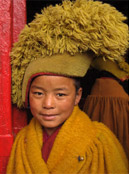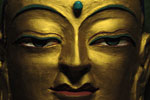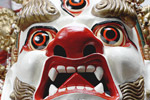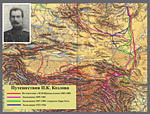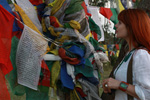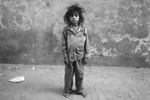The Statement of Sikyong Dr. Lobsang Sangay on the Twenty Fifth Birthday of the 11th Kunzik Panchen Gedun Choekyi Nyima
April 25, 2014
The commemoration of the 25th birthday of the 11th Kunzik Panchen Gedun Choekyi Nyima is an occasion of joy but also great pain. On one hand, it gives us immense joy that His Holiness the Dalai Lama was able to recognize the authentic reincarnation of the Panchen Lama. But this joy is profoundly undermined by the memory of the time when the Panchen Lama and his family were taken captive by the Chinese authorities. For all Tibetans, it is a source of great sorrow that to this day the state of the Panchen Lama’s physical and mental health remains unknown. His very existence is in doubt and he has not been seen since being taken into captivity on May 17, 1995.
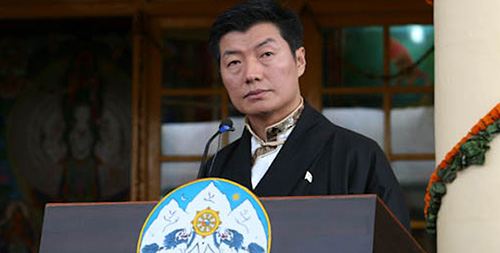
Had the 11th Kunzik Panchen Lama received proper education and traditionally trained like other Lamas, by now he would be an eminent teacher teaching Buddhism to fellow Tibetans and citizens throughout the world.
Recognizing the reincarnation of the Panchen Lamas and other Tibetan spiritual teachers is a religious prerogative that falls solely within the domain of Tibetan spirituality. The identification and selection process of Tibetan spiritual leaders is not a political matter, particularly, not for the Chinese Communist Party, a self-claimed atheist organization responsible for destroying Tibetan Buddhism, has no right to appoint.
Emphasizing the centrality of the Dalai Lamas and Panchen Lamas to Tibet and the Tibetan people and the close relationship between the two, the 10th Panchen Lama declared in 1986 at the Monlam Chenmo (the Great Prayer Festival), in Lhasa that “His Holiness and I are spiritual friends. We have no differences between us…If we are united, the Tibetan nationality will progress and Buddhism will flourish.”
The distinguished 10th Kunzik Panchen Lobsang Trinley Lhundup Choekyi Gyaltsen devoted his whole life to the welfare of the Tibetan people. On May 18, 1962, at the age of 24, he bravely presented to Mao Zedong and other Chinese leaders the 70,000 Character Petition, a document that thoroughly assessed the nature of Chinese occupation in Tibet. It elaborately explained the Tibetan people’s grievances and suggested measures to uplift them from political repression. The petition also exposed the Chinese government’s use of routine propaganda regarding revolution, liberation, democratic reform and the so-called ‘socialist paradise’ as pure deception.
In the 70,000 character petition, the Panchen Lama wrote, “Before democratic reform, there were more than 2500 large, medium and small monasteries in Tibet. After democratic reform, only 70 or so monasteries were kept in existence by the Chinese government. This was a reduction of more than 97 percent. …. the number of monks and nuns living in the monasteries was about 7000 people, which is a reduction of 93 percent.” In Tibetan areas of the neighboring provinces of Sichuan, Yunnan and Gansu, “…the number of monasteries and of monks reduced by between 98% and 99%.”
Commenting on the death and disappearance of Tibetan people, the Panchen Lama shared, “We have no way of knowing in detail the number of Tibetans who were arrested after the rebellion, but from the appearance of things it may be inferred that the number of people who were locked up reached about ten thousand or more in every area. Therefore, if we say that all these people were the enemy, we can affirm that hardly anyone is left among us Tibetan, apart from women, old people, children and a very small number of young men.”
Mao called the petition “a poisoned arrow shot at the party by reactionary feudal overlords.” Because of Mao’s strong denunciation, the 10th Panchen Lama was publicly denounced and humiliated, sentenced to imprisonment, and subjected to solitary confinement. After 14 long years of detention and suffering, he emerged as a middle aged man.
Years of imprisonment and torture did not shake his courage and devotion to his people. In 1980, when the Panchen Lama was restored his old title of the Vice-Chairman of the National People’s Congress, the great Tibetan leader continued to dedicate all his efforts to restoring Tibetan religion and culture which had been almost completely destroyed even prior to the disaster of the Cultural Revolution. In his 1962 petition, he had sworn an oath that in future, “I will certainly not allow any trace to be left in my history which would tarnish my reputation as a descendant of the hardworking and brave Tibetan nationality.” He remained completely true to this vow.
Because of the 10th Panchen Lama’s efforts, a law was passed in 1987 making Tibetan the official language of the Tibet Autonomous Region.
During his last days, in Shigatse, on 23rd and 24th January 1989, the Panchen Lama gave two momentous speeches—one to the local officials about the critical situation of Tibet and the other to the reincarnated lamas about the recognition of tulkus. In his speech to the local officials, he categorically stated, “Since liberation, there has certainly been development, but the price paid for this development has been greater than the gains.”
Sadly, four days later, on January 28, 1989, he was found dead at his monastery under mysterious circumstance. He died at the age of 51. He was survived by his wife and daughter Pan Rinzin Wangmo.
On May 14, 1995, His Holiness the Dalai Lama recognized a six-year old boy in Tibet, Gedun Choekyi Nyima, as the authentic reincarnation of the 10th Panchen Lama. Soon thereafter, Gedun Choekyi Nyima and his family were abducted by the Chinese authorities. He was six years old by then and the youngest political prisoner in the world.
On behalf of the Central Tibetan Administration, I appeal to the international community to make a concerted effort to press China to release Gedun Choekyi Nyima. The international community must make it plain to China that flagrant human rights violations such as the disappearance of the 11th Panchen Lama cannot be papered over by business and commerce.
I also directly appeal to the Chinese authorities to release Gedun Choekyi Nyima, his family and other prisoners of conscience. This would be a large step forward to restoring China’s moral leadership in the world.
By:
tibet.net
![]()
![]()
![]()
![]()
